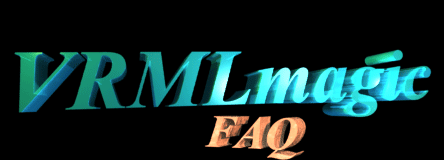|
|
 |
Web3D Information
This section answers many of the common questions about Web3D, including:
- What is Web3D ?
- What is the Web3D Consortium ?
- What does the Web3D Consortium do ?
- Who controls Web3D ?
- How does Web3D relate to Scintillating Graphics ?
- Can I be part of Web3D ?
- Is Web3D a format/standard ?
- How does VRML relate to Web3D ?
- How does X3D relate to Web3D ?
- How does VRMLmagic relate to Web3D ?
- Other Useful Web3D References
What is Web3D ?
Essentially Web3D is the "concept" of interactive 3D content as displayed via the world wide web with the overall goal of making the users experience better.
The Web3D Consortium describe Web3D as follows:
| Web3D blends the intuitive human sense of space and time with user interface interaction and programming language integration producing a truly new and exciting technology for the Internet. The evolution of the Net from command-line to 2D graphical to emergent 3D interfaces reflects ongoing, fundamental progress toward human-centered interface design--that is, toward a more immersive and responsive computer-mediated experience. |
What is the Web3D Consortium ?
The Web3D consortium is a body made up of parties interested in furthering the development of 3D graphics and its applications on the web. They describe themselves on the Web3D Consortiums site as:
| The Web3D Consortium was formed to provide a forum for the creation of open standards for Web3D specifications, and to accelerate the worldwide demand for products based on these standards through the sponsorship of market and user education programs. Web3D applications have been actively pursued by many organizations for quite some time. This community has spearheaded the development of the VRML 1.0 and 2.0 specifications, which provide the basis for the development of associated applications. The organizations involved in this effort felt that the creation of an open consortium focused exclusively on Web3D would provide the structure necessary to stabilize, standardize, and nurture the technology for the entire community. |
What does the Web3D Consortium do ?
Essentially the Web3D consortium is about designing, discussing and defining standards/formats for 3D web content (ie. Web3D). They describe their activities as:
| Today, the Web3D Consortium is utilizing its 1500-2000 strong Internet development community, and its broadbased industry support to systematically move the VRML97 ISO Standard forward. Our many prominent technical activities include the Extensible 3D (X3D) specification, which is extending VRML97, using the Extensible Markup Language (XML). Through the well-coordinated efforts of dedicated Working and Task Groups and ISO/W3C Liaisons, the Web3D Consortium is maintaining and extending its standardization activities well into the next Millennium. |
Who controls Web3D ?
One of the strengths of Web3D is that it is not centrally controlled. Membership in the Web3D consortium is available to all (although there are quite high costs for commercial members). Decisions are made by inclusive voting processes involving members. In their words, control and decisions are made as follows:
|
The Web3D Consortium maintains mailing lists for general Web3D issues and specific Working Groups which collaborate openly on developing Web3D Recommended Practices, standards, and technologies and function under the jurisdiction of one or more of the Consortium's Teams. The Teams review and vote on proposals provided by Working Groups, following a well-documented, tried-and-true process. The process includes six-monthly pulse checks where groups report their progress and status. Teams are run by the membership and report to the Board of Directors. The Board of Directors is nominated from and voted on by the membership. |
How does Web3D relate to Scintillating Graphics ?
As the developer of VRMLmagic, which is obviously a Web3D authoring package. Scintillating Graphics has a strong interest and involvement with Web3D and in particular its decisions involving formats for 3D web content. As the Web3D body develops and defines these formats Scintillating Graphics keeps involved with the latest developments to ensure that our software is outputting and making use of the best available formats and technologies.
Can I be part of Web3D ?
Yes. In fact the Web3D consortium is keen to involve/include as many people as possible. Depending on the type of membership you seek (eg. commercial memberships are more expensive), the cost to become a member varies significantly. For more details on the costs and benefits involved take a look at the Web3D Membership page.
Is Web3D a format/standard ?
No. Web3D is not a standard or format.Web3D is the body/group that defines the key formats relating to 3D content and the web (eg. they create standards like VRML, X3D etc).
How does VRML relate to Web3D ?
VRML is a format for 3D content on the web. The VRML format was designed and developed by the Web3D consortium (although the name Web3D came after the initial versions of VRML). So in simple terms the Web3D group are the people who created the VRML format.
How does X3D relate to Web3D ?
X3D is a format for 3D content on the web. The X3D format is being designed and developed by the Web3D consortium. So in simple terms the Web3D group are the people who are creating the X3D format.
How does VRMLmagic relate to Web3D ?
VRMLmagic is an X3D/VRML authoring package, its goal is to aid users in designing and building interactive 3D web pages. As the Web3D consortium is the group that are defining the standards for 3D web content/pages, The two relate in that VRMLmagic makes use of the formats and standards (for 3D web content eg. VRML, X3D) as specified by the Web3D Consortium.
Other Useful Web3D References
The Web3D Consortium - the definitive site for information regarding Web3D
VRML Information - our brief description of VRML and how it works
X3D Information - our brief description of X3D and how it works
VRMLmagic - our X3D/VRML Authoring Software
